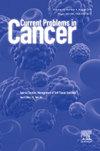肺母细胞瘤(PB) 17例临床特点及治疗分析
IF 2.3
4区 医学
Q3 ONCOLOGY
引用次数: 0
摘要
前言总结肺母细胞瘤的疾病特点,分析相关预后因素,分享诊断和治疗过程。方法回顾性分析1994年1月至2024年12月山东省立医院收治的17例肺母细胞瘤患者的临床资料。结果患者以中老年男性为主,临床表现以咳嗽、咳痰、胸闷、气短为主。胸部CT结合血清神经元特异性烯醇化酶(NSE)升高可能有助于诊断。病理类型以双相型为主,其次为上皮型,亚型不明确。肿瘤多发于右肺,诊断时多为T4期或伴有局部淋巴结转移。Ki-67阳性细胞存活率越高,存活时间越短。目前肺叶切除术是一种有效的治疗方法,术后放疗可提高部分患者的生存时间。5年生存率为29.4%。Cox回归分析显示,性别和肿瘤分期对肺母细胞瘤患者的预后有统计学意义。Kaplan-Meier生存曲线验证显示,T4期患者的生存时间明显短于早期患者(Log-rank p=0.011)。结论肺母细胞瘤的术前诊断具有挑战性,以双相型为主要病理亚型。诊断时的晚期是导致预后不良的关键因素。儿童和成人患者在年龄上有显著差异。肿瘤分期是影响预后的关键因素,Ki-67阳性率与生存时间呈负相关。强调根据病理分型和肿瘤分期制定治疗策略,可为提高诊治水平提供参考。本文章由计算机程序翻译,如有差异,请以英文原文为准。
Clinical characteristics and treatment analysis of pulmonary blastoma (PB): a report of 17 cases
Introduction
To summarize the disease characteristics of pulmonary blastoma, analyze related prognostic factors, and share the diagnosis and treatment process.
Methods
This study retrospectively analyzed the clinical data of 17 patients with pulmonary blastoma admitted to Shandong Provincial Hospital from January 1994 to December 2024.
Results
The patients were predominantly middle-aged and elderly males, with clinical manifestations mainly including cough, sputum production, chest tightness, and shortness of breath. Chest CT combined with elevated serum neuron-specific enolase (NSE) may assist in diagnosis. The pathological types were predominantly biphasic, followed by epithelial type and those with unclear subtypes. Tumors were more likely to occur in the right lung, and most were at T4 stage or accompanied by regional lymph node metastasis at the time of diagnosis. The higher the Ki-67 positive cell viability rate, the shorter the survival time. Lobectomy is currently an effective treatment, and postoperative radiotherapy can improve the survival time of some patients. The 5-year survival rate was 29.4%. Cox regression analysis showed that gender and tumor stage T had statistical significance for the prognosis of patients with pulmonary blastoma. Verification via Kaplan-Meier survival curves revealed that the survival time of patients with T4 stage was significantly shorter than that of patients with early-stage disease (Log-rank p=0.011).
Conclusions
Preoperative diagnosis of pulmonary blastoma is challenging, with the biphasic type being the predominant pathological subtype. The advanced stage at the time of diagnosis is a key factor for poor prognosis. There is a significant difference in age between pediatric and adult patients. Tumor stage is a key factor affecting prognosis, and the Ki-67 positivity rate is negatively correlated with survival time. Emphasizing the formulation of treatment strategies based on pathological types and tumor stages can provide a reference for improving the level of diagnosis and treatment.
求助全文
通过发布文献求助,成功后即可免费获取论文全文。
去求助
来源期刊

Current Problems in Cancer
医学-肿瘤学
CiteScore
5.10
自引率
0.00%
发文量
71
审稿时长
15 days
期刊介绍:
Current Problems in Cancer seeks to promote and disseminate innovative, transformative, and impactful data on patient-oriented cancer research and clinical care. Specifically, the journal''s scope is focused on reporting the results of well-designed cancer studies that influence/alter practice or identify new directions in clinical cancer research. These studies can include novel therapeutic approaches, new strategies for early diagnosis, cancer clinical trials, and supportive care, among others. Papers that focus solely on laboratory-based or basic science research are discouraged. The journal''s format also allows, on occasion, for a multi-faceted overview of a single topic via a curated selection of review articles, while also offering articles that present dynamic material that influences the oncology field.
 求助内容:
求助内容: 应助结果提醒方式:
应助结果提醒方式:


